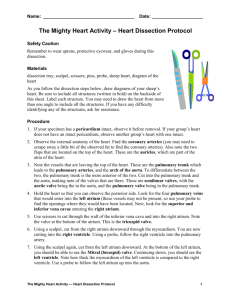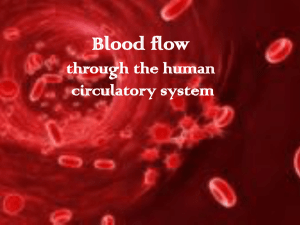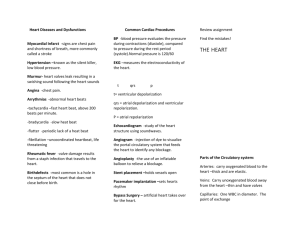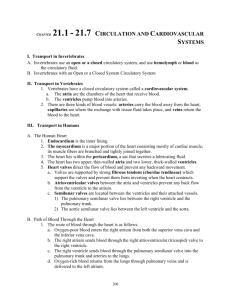BIO 211
advertisement
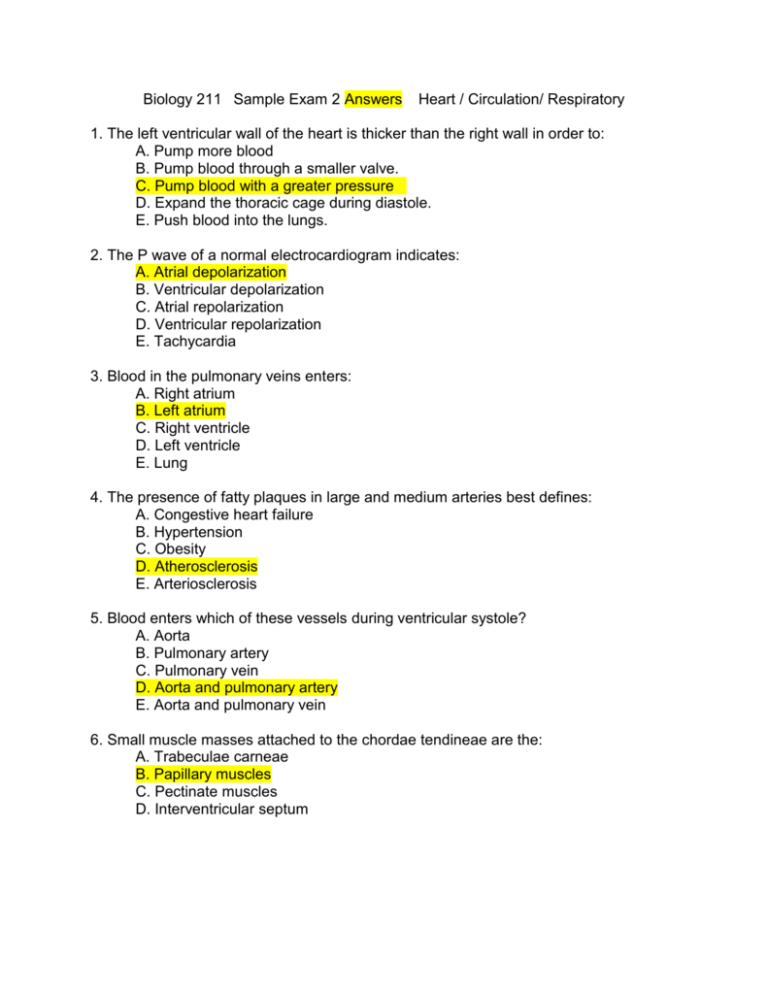
Biology 211 Sample Exam 2 Answers Heart / Circulation/ Respiratory 1. The left ventricular wall of the heart is thicker than the right wall in order to: A. Pump more blood B. Pump blood through a smaller valve. C. Pump blood with a greater pressure D. Expand the thoracic cage during diastole. E. Push blood into the lungs. 2. The P wave of a normal electrocardiogram indicates: A. Atrial depolarization B. Ventricular depolarization C. Atrial repolarization D. Ventricular repolarization E. Tachycardia 3. Blood in the pulmonary veins enters: A. Right atrium B. Left atrium C. Right ventricle D. Left ventricle E. Lung 4. The presence of fatty plaques in large and medium arteries best defines: A. Congestive heart failure B. Hypertension C. Obesity D. Atherosclerosis E. Arteriosclerosis 5. Blood enters which of these vessels during ventricular systole? A. Aorta B. Pulmonary artery C. Pulmonary vein D. Aorta and pulmonary artery E. Aorta and pulmonary vein 6. Small muscle masses attached to the chordae tendineae are the: A. Trabeculae carneae B. Papillary muscles C. Pectinate muscles D. Interventricular septum 7. Which of the following is not part of the conduction system of the heart? A. AV node B. Bundle of His C. AV valve D. SA node 8. Blood is carried to capillaries in the myocardium by way of: A. The coronary sinus B. Fossa ovale C. Coronary arteries D. Coronary veins 9. The tricuspid valve is closed: A. While the ventricle is in diastole B. By the movement of blood from atrium to ventricle C. While atrium is contracting D. When the ventricle is in systole E. During all of the above Match the following A. Myocardium B. Epicardium C. Endocardium D. Parietal pericardium 10. The outermost layer of the pericardial sac D 11. The inside lining of the heart C 12. Heart muscle A 13. Serous membrane layer outside or covering the surface of the heart B 14. Which statement best describes arteries? A. All carry oxygenated blood to the heart. B. All contain valves to prevent the back-flow of blood. C. All carry blood away from the heart D. Only large arteries are lined with endothelium E. Only muscular arteries contain smooth muscle. 15. Which of the following are involved directly in pulmonary circulation? A. Superior vena cava, right atrium, and left ventricle B. Inferior vena cava, right atrium, and left ventricle C. Right ventricle, pulmonary artery, and left atrium D. Left ventricle, aorta, and inferior vena cava E. Right atrium, aorta, left ventricle 16. Which tunic of an artery contains endothelium? A. Intima B. Media C. Externa D. Adventitia 17. Permitting the exchange of nutrients and gases between the blood and tissue cells is the primary function of: A. Capillaries B. Arteries C. Veins D. Arterioles 18. The arteries that directly feed the capillary beds are called: A. Muscular arteries B. Arterioles C. Elastic arteries D. Aorta 19. Factors which aid venous return include all except: A. Activity of skeletal muscles B. Pressure changes in the abdominal and thoracic cavities during respiration C. Venous valves D. Greater uriinary output Peripheral resistance (Answer A for TRUE and B for FALSE) 20. Increases as blood viscosity increases A 21. Decreases with increasing length of blood vessel B 22. Increases as blood vessel diameter increases B MATCH A. Large arteries B. Arterioles C. Capillaries D. Venules E. Large veins 23. Site where resistance to blood flow is greatest B 24. Site where blood is flowing fastest A 25. Site where blood is flowing slowest C 26. Site where histamine increases permeability D 27. Site where blood pressure is greatest A 28. Site where exchanges of nutrients and gases are made C 29. Slowing down the heart rate is a function of the: A. Parasympathetic nervous system B. Sympathetic nervous system C. SA node D. Epinephrine E. AV node 30. The structure of a capillary wall differs from the wall of a vein or artery because: A. It has two tunics instead of one. B. There is less smooth muscle. C. It is a single layer - only a tunica intima. D. There are no endothelial cells. 31. Which sequence of events best represents the intrinsic conduction of an impulse through the heart? 1. 2. 3. 4. Sinoatrial node Atrioventricular node Purkinje fibers Bundle of HIS A. 1, 4, 3, 2 B. 1, 2, 3, 4, C. 1, 3, 2, 4 D. 1, 2, 4, 3 32. Arterial blood pressure increases if: A. Blood volume is lost B. Peripheral resistance falls C. Peripheral resistance increases D. Viscosity of the blood decreases E. Maximal vasodilation is achieved 33. The normal pacemaker of the heart is the: A. A-V Node B. Bundle of HIS C. Purkinje fibers D. S-A Node 34. Arterial blood pressure depends on: A. Cardiac output B. Blood volume C. Peripheral resistance D. All of these 35. Cardiac output equals: A. Stroke volume times heart rate B. Heart rate divided by stroke volume C. Stroke volume plus heart rate D. Heart rate times blood pressure 36. The valve between the right atrium and the right ventricle is the: A. Tricuspid valve B. Bicuspid valve (Mitral) C. Aortic semilunar valve D. Pulmonic semilunar valve E. No valve is needed 37. A heart rate less than 60 beats a minute is: A. Tachycardia B. Bradycardia C. Normal sinus rhythym D. Heart block E. Atherosclerosis 38. Smooth muscle and elastin of vessels would be found in the: A. Tunica media B. Tunica adventitia C. Tunica intima D. Vaso vasorum 39. The mean arterial blood pressure is: A. The average of the systolic and diastolic pressure B. Closer to the systolic pressure C. Closer to the diastolic pressure D. The pulse pressure 40. If the atrioventricular valves are open during ventricular systole the blood would: A. Exit via the arteries B. Enter the atria C. Enter the lungs D. Remain in the ventricles 41. Pressure in the left ventricle must exceed the pressure in the blood into the systemic circuit. A. Pulmonary artery B. Brachiocephalic artery C. Left atrium D. Right ventricle E. Aorta to eject 42. The quiescent phase, or relaxation of all chambers in the cardiac cycle, is during: A. QRS complex B. Ventricular systole C. The interval between the end of the T wave and P wave D. Interval preceding the QRS complex E. Atrial systole 43. The flow of blood from the cerebral circulation: 1. Right atrium 2. Left atrium 3. Pulmonary vein 4. Pulmonary artery 5. Left ventricle 6. Right ventricle 7. Carotid artery 8. Jugular vein (returns blood from the head and is near carotid artery) 9. Inferior vena cava 10. Superior vena cava 11. Aortic arch 12. Abdominal aorta 13. Thoracic aorta 14. Lungs A. 10,1,6,3,14,4,2,5,11,12,13,8 B. 2,5,3,14,4,1,6,11,13,12,7,10 C. 8,10,1,6,4,14,3,2,5,11,7 D. 8,9,2,5,4,14,3,1,4,13,7 44. Semilunar valves are located: A. Atria and ventricles B. Where veins enter the atria C. Where arteries leave the ventricles D. At the intraventricular septum 45. In Starlings Law of the Capillary, the driving force for filtration is largely due to: A. A higher hydrostatic pressure on the arteriole end of the capillary B. A higher hydrostatic pressure on the venule side of the capillary C. A large osmotic pressure due to proteins pulling fluid into the interstitium D. A large osmotic pressure due to proteins driving fluid out of the capillaries 46. If the right side of the heart is affected in congestive heart failure the result would be: A. Pooling of blood in the systemic circuit and edema B. Pooling of blood and edema in the lungs C. The myocardium cannot contract D. Pooling of blood in both atria E. None of these 47. The first and second heart sounds are due to: A. Muscle contraction B. Opening of valves C. Closing of valves D. Blood rushing into aorta 48. Contraction always follows: A. Repolarization B. Depolarization C. Refractory period D. Cardiac cycle E. The T wave 49. Closing of the AV and semilunar valves: A. Can be seen on the ECG B. Make up the first and second heart sounds C. Cannot be heard D. Occur at the same time 50. Repolarization of the atria: A. Occurs with the P wave B. Follows the QRS complex C. Occurs during the QRS complex D. Occurs at the T wave E. Does not occur 51. The pointed end of the heart is the: A. Base B. Intraventricular septum C. Coronary sinus D. Apex 52. Deoxygenated blood leaves the heart in the: A. Aorta B. Pulmonary artery C. Pulmonary vein D. Vena cava 53. The volume of blood in the ventricles at the end of the ventricular relaxation is the: A. End systolic volume B. End diastolic volume C. Stroke volume D. Cardiac output 54. The amount of blood leaving the heart with each beat is the: A. Cardiac output B. End systolic volume C. End diastolic volume D. Stroke volume 55. This reflex results in increasing rate and force of the heartbeat and blood pressure to relieve blood congestion in the heart. A. Carotid sinus reflex B. Aortic reflex C. Bainbridge reflex D. Tachycardia 56. The fetal connection between the pulmonary trunk and the aorta is the: A. Ductus arteriosus B. Foramen ovale C. Pulmonary vein D. Aortic arch 57. An ECG provides information on: A. Electrical activity of the heart B. Heart murmurs C. Cardiac output D. All of these 58. The chordae tendineae: A. Open the semilunar valves B. Prevent the AV valves trom entering the atria C. Contract the papillary muscles D. Close the AV valves E. Close the semilunar valves 59. An alternate pathway or branch in a vessel is a(an): A. Anastomosis B. Arteriosus C. Vaso vasorum D. Sinus 60. Blood vessels to the blood vessels are the: A. Anastomosis B. Vaso vasorum C. Capillaries D. Coronary circulation E. Mesentary circulation 61. Tidal volume is air: A. Forcibly exhaled after normal expiration. B. Exchanged during normal breathing. C. Inhaled after normal inspiration. D. Remaining in lungs after forced expiration. E. Total volume that lungs can hold. 62. The nose serves all the following functions except: A. As a passageway for air movement. B. As the initiator of the cough reflex. C. Warming the air. D. Humidifying or adding moisture to the inhaled air. E. Cleansing the air. 63. The lung volume which represents the total volume of exchangeable air is the: A. Tidal volume. B. Vital capacity. C. Inspiratory capacity. D. Expiratory reserve volume. E. Residual air. 64. The concentration of oxygen and/or total atmospheric pressure is lower at high altitudes therefore the body will compensate to deliver more oxygen to tissues by: A. Making more erythrocytes B. Making more leukocytes C. Increasing metabolic rate D. Decreasing ph E. All of these will occur over time 65. Amount of air that can be inspired above the tidal volume: A. Residual volume B. Expiratory reserve C. Inspiratory reserve. D. Vital capacity E. Tidal volume 66. The most important factor that prevents dust and small particles from entering the lungs after air has passed the nasal cavity is: A. Abundant blood supply to the respiratory system B. Ciliated mucous producing cells that line the respiratory system. C. Particles are trapped by hair that lines the airways. D. Bronchioconstriction E. Action of the epiglottis 67. Oxygen and carbon dioxide are exhanged in the lungs and through all cell membranes by: A. Active transport B. Diffusion C. Filtration D. Osmosis 68. Identify the structure with the smallest diameter: A. Primary bronchus B. Bronchiole C. Trachea D. Secondary bronchus E. Larynx 69. If the partial pressure of oxygen in the atmosphere were to be increased and all other gasses remained the same: A. More oxygen would move from the blood to the alveolar B. Air space. C. More oxygen would move into the blood D. More carbon dioxide would move into the blood E. More carbon dioxide would move into the alveoli from the blood. 70. If the PO2 of air in the alveoli is 100mmhg, then the PO 2 of blood in the pulmonary vein would be about: A. 40mm Hg (the same as the tissue) B. 100mm Hg C. Much greater than 100mm Hg D. The pulmonary venous system has no oxygen E. Not enough information 71. A normal expiration involves: A. Contraction of respiratory muscles and air rushes in B. Relaxation of respiratory muscles and air rushes in C. Relaxation of respiratory muscles and air rushes out D. Contraction of respiratory muscles and air rushes out 72. The functional unit of the respiratory system is the: A. Bronchus B. Larynx C. Bronchiole D. Alveolus 73. The diffusion of oxygen from the blood to body tissues is dependent upon which of the following? A. High partial pressure of oxygen in body tissues B. Decrease in body temperature C. Low partial pressure of oxygen in body tissues D. Low partial pressure of carbon dioxide in body tissues 74. Air moves into the lungs during inspiration because: A. The pressure inside the thorax increases B. The pressure inside the thorax decreases C. Oxygen and carbon dioxide are exchanged D. The diaphragm relaxes 75. The substance produced by the alveoloar cells that helps reduce surface tension and decreases their tendency to collapse is: A. Carbonic anhydrase B. Mucus C. Surfactant D. Pleural fluid 76. Which of the following staements about the C-shaped rings of cartilage of the trachea is incorrect? A. They prevent collapse of the trachea during swallowing. B. They maintain an open airway. C. They contain hyaline cartilage. D. They form a complete circle in the trachea. 77. The cartilage which routes substances away from the respiratory system during swallowing is the: A. Glottis B. Palate C. Uvula D. Thyroid cartilage E. Epiglottis 78. The membrane that forms the covering on the outer surface of the lungs: A. Parietal pleura B. Visceral pleura C. Parietal peritoneum D. Visceral peritoneum E. Messentary 79. According to the ideal gas law, if the temperature is constant and volume increases the pressure: A. Increases B. Decreases C. Is constant D. Ceases 80. This reflex prevents over inflation of the lungs: A. Bainbridge B. Herring Breuer C. Cough D. Dalton's 81. The diaphragm contacts during: A. Expiration B. Inspiration C. Digestion D. Perspiration



